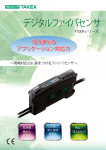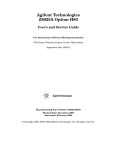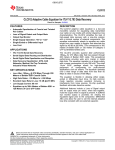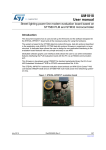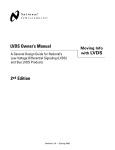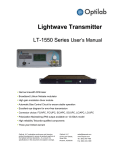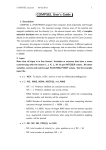Download CLC018 8 x 8 Digital Crosspoint Switch, 1.485
Transcript
OBSOLETE CLC018 www.ti.com SNLS019C – MAY 2004 – REVISED AUGUST 2006 CLC018 8 x 8 Digital Crosspoint Switch, 1.485 Gbps Check for Samples: CLC018 FEATURES DESCRIPTION • The CLC018 is a fully differential 8x8 digital crosspoint switch capable of operating at data rates exceeding 1.485 Gbps per channel. Its non-blocking architecture utilizes eight independent 8:1 multiplexers to allow each output to be independently connected to any input and any input to be connected to any or all outputs. Additionally, each output can be individually disabled and set to a high-impedance state. This TRI-STATE feature allows flexible expansion to larger switch array sizes. 1 2 • • • • • • • Supports SMPTE 259M, SMPTE 344M, and SMPTE 292M Fully Differential Signal Path Non-Blocking Flexible Expansion to Larger Array Sizes with Very Low Power Single +5/−5V or Dual ±5V Operation TRI-STATE Outputs Double Row Latch Architecture 64-Lead QFP Package APPLICATIONS • • • • • • • Routing Switchers Production Switchers Master Control Switchers Telecom/Datacom Switchers Storage Area Network (SAM) Packet Switching ATM SONET KEY SPECIFICATIONS • • • • High Speed: >1.485 Gbps Low Jitter: – <50 psPP for Rates <500 Mbps – <100 psPP for Rates <1.485 Gbps Low Power; 850 mW with all Outputs Active Fast Output Edge Speeds: 250 ps Low channel-to-channel crosstalk allows the CLC018 to provide superior all-hostile jitter of 50 psPP. This excellent signal fidelity along with low power consumption of 850 mW make the CLC018 ideal for digital video switching plus a variety of data communication and telecommunication applications. The fully differential signal path provides excellent noise immunity, and the I/Os support ECL and PECL logic levels. In addition, the inputs may be driven single-ended or differentially and accept a wide range of common mode levels including the positive supply. Single +5V or −5V supplies or dual +5V supplies are supported. Dual supply mode allows the control signals to be referenced to the positive supply (+5V) while the high-speed I/O remains ECL compatible. The double row latch architecture utilized in the CLC018 allows switch reprogramming to occur in the background during operation. Activation of the new configuration occurs with a single “configure” pulse. Data integrity and jitter performance on unchanged outputs are maintained during reconfiguration. Two reset modes are provided. Broadcast reset results in all outputs being connected to input port DI0. TRISTATE Reset results in all outputs being disabled. The CLC018 is fabricated on a high-performance BiCMOS process and is available in a 64-lead plastic quad flat pack (QFP). 1 2 Please be aware that an important notice concerning availability, standard warranty, and use in critical applications of Texas Instruments semiconductor products and disclaimers thereto appears at the end of this data sheet. All trademarks are the property of their respective owners. PRODUCTION DATA information is current as of publication date. Products conform to specifications per the terms of the Texas Instruments standard warranty. Production processing does not necessarily include testing of all parameters. Copyright © 2004–2006, Texas Instruments Incorporated OBSOLETE CLC018 SNLS019C – MAY 2004 – REVISED AUGUST 2006 www.ti.com CLC018 BLOCK DIAGRAM These devices have limited built-in ESD protection. The leads should be shorted together or the device placed in conductive foam during storage or handling to prevent electrostatic damage to the MOS gates. ABSOLUTE MAXIMUM RATINGS (1) (2) −0.3V to +6.0V Supply Voltage (VCC–V EE) VLL Maximum VCC +6V VCC −0.5V VLL Minimum −65°C to +150°C Storage Temperature Range Lead Temp. (Soldering 4 sec.) +260°C ESD Rating Package Thermal Resistance Reliability Information (1) (2) TBD θJA 64-Pin QFP 75°C/W θJC 64-Pin QFP 15°C/W Transistor Count 3000 Absolute Maximum Ratings are those values beyond which the safety of the device cannot be ensured. They are not meant to imply that the devices should be operated at these limits. The table of Electrical Characteristics specifies conditions of device operation. If Military/Aerospace specified devices are required, please contact the Texas Instruments Sales Office/Distributors for availability and specifications. RECOMMENDED OPERATING CONDITIONS Supply Voltage (VCC–V EE) 4.5V to 5.5V Operating Temperature −40°C to +85°C VLL VCC or VCC +5V 2 Submit Documentation Feedback Copyright © 2004–2006, Texas Instruments Incorporated Product Folder Links: CLC018 OBSOLETE CLC018 www.ti.com SNLS019C – MAY 2004 – REVISED AUGUST 2006 ELECTRICAL CHARACTERISTICS (VCC = 0V, VEE = −5V, VLL = 0V; unless otherwise specified) (1) . Parameter Typ +25°C Conditions Min/Max +25°C (2) Min/Max −40°C to +85°C (2) Units DYNAMIC PERFORMANCE Max. Data Rate/Channel (NRZ) Channel Jitter See (3) Data Rate <500 Mbps (4) Data Rate <1.485 Gbps (4) Propagation Delay (input to output) 1.485 Gbps 50 psPP 100 psPP 0.75 ns Propagation Delay Match See (5) ±200 ps Output Rise/Fall Time See (6) 250 ps Duty Cycle Distortion See (7) 10 ps OA Bus to LOAD ↑ Setup Time (T1) 15 ns LOAD ↓ to OA Bus Hold Time (T2) 0 ns IA Bus, TRI to LOAD ↓ Setup Time (T3) 5 ns LOAD ↓ to IA Bus, TRI Hold Time (T4) 5 ns LOAD 10 ns CNFG CONTROL TIMING: CONFIGURATION (8) Min Pulse Width: (T5) 10 ns LOAD ↑ to CNFG ↑ Delay (T6) 0 ns CNFG ↑ to Valid Delay (T7) 20 ns CNFG ↑ to Output TRI-STATE Delay (T8) 20 ns CNFG ↑ to Output Active Delay (T9) 70 ns 5 ns RES ↓ to TRI Hold Time (T11) 5 ns Min Pulse Width: RES (T12) 10 ns RES ↑ to TRI-STATE Mode Delay (T13) 20 ns RES ↑ to Broadcast Mode Delay (T14) 70 ns CONTROL TIMING: RESET (9) TRI to RES ↑ Setup Time (T10) STATIC PERFORMANCE Signal I/O: Min Input Swing, Differential (See (10) ) 150 Input Voltage Range Lower Limit −2 Input Voltage Range Upper Limit 0.4 Input Bias Current (See (10) Output Current (See (10) Output Voltage Swing RLOAD = 75Ω and (11) ) ) 200 200 mVPP V V 1.5 0.4/3.1 0.3/3.8 µA/output 10.7 8.53/12.80 7.20/14.3 mA 800 640/960 540/1060 mV Output Voltage Range Lower Limit −2.5 V Output Voltage Range Upper Limit 0 V (1) (2) VLL and all VEE supply pins are bypassed with 0.01 µF ceramic capacitor. Min/max ratings are based on product characterization and simulation. Individual parameters are tested as noted. Outgoing quality levels are determined from tested parameters. (3) Bit error rate less than 10−9 over 50% of the bit cell interval. (4) Measured using a pseudo-random (2 23−1 pattern) binary sequence with all other channels active with an uncorrelated signal. (5) Spread in propagation delays for all input/output combinations. (6) Measured between the 20% and 80% levels of the waveform. (7) Difference in propagation delay for output low-to-high vs. output high-to-low transition. (8) Refer to the Configuration Timing Diagram. (9) Refer to the Reset Timing Diagram. (10) J-level spec. is 100% tested at +25°C. (11) The bias current for high speed data input depends on the number of data outputs that are selecting that input. Submit Documentation Feedback Copyright © 2004–2006, Texas Instruments Incorporated Product Folder Links: CLC018 3 OBSOLETE CLC018 SNLS019C – MAY 2004 – REVISED AUGUST 2006 www.ti.com ELECTRICAL CHARACTERISTICS (continued) (VCC = 0V, VEE = −5V, VLL = 0V; unless otherwise specified)(1) . Typ +25°C Min/Max +25°C (2) Min/Max −40°C to +85°C (2) Units ) −1 −0.5 −0.5 V ) Parameter Conditions Control Inputs: (See (12) Input Voltage - LOW V IL max (See (12) −4 −4.5 −4.5 V Input Voltage - HIGH V IH min VLL = +5V (12) 4 4.5 4.5 V Input Voltage - LOW V IL max VLL = +5V (12) 1 0.5 0.5 V Input Voltage - HIGH V IH min (12) Input Current - HIGH VIH = VLL Input Current - LOW VIL = VLL −5V (12) 1 0.2/2.0 0.1/2.5 µA −100 −200/10 −250/15 µA 157 127/202 119/217 mA MISCELLANEOUS PERFORMANCE VCC Supply Current All Outputs Active (12) (13) (14) (12) VCC Supply Current All Outputs TRI-STATE 7 3/11 2/12 mA VLL Supply Current VLL = 0V (12) 2.5 1.7/3.3 1.5/3.5 mA VLL Supply Current VLL = +5V (12) 7 mA 1.5 pF 2 pF Input Capacitance Output Capacitance (12) J-level spec. is 100% tested at +25°C. (13) The VCC supply current is a function of the number of active data outputs. IVCC 18*N + 7 mA where N is an integer from 0 to 8. (14) IVEE = IVCC + I VLL. 4 Submit Documentation Feedback Copyright © 2004–2006, Texas Instruments Incorporated Product Folder Links: CLC018 OBSOLETE CLC018 www.ti.com SNLS019C – MAY 2004 – REVISED AUGUST 2006 TYPICAL PERFORMANCE CHARACTERISTICS Figure 1. Figure 2. Figure 3. Figure 4. Figure 5. Figure 6. Submit Documentation Feedback Copyright © 2004–2006, Texas Instruments Incorporated Product Folder Links: CLC018 5 OBSOLETE CLC018 SNLS019C – MAY 2004 – REVISED AUGUST 2006 www.ti.com CONNECTION DIAGRAM Figure 7. 64-Lead QFP- Top View See Package Number NBH0064A PIN DESCRIPTIONS POWER PINS VCC is the most positive rail for the data path. When the data levels are ECL compatible, then VCC should be connected to GND. For PECL data (+5V referenced ECL), VCC is connected to the +5V supply. Please refer to the Device Operation section in this datasheet for recommendations on the bypassing and ground/power plane requirements of this device. VEE is the most negative rail for the data path. When the data levels are ECL compatible, then VEE is connected to a −5.2V power supply. For PECL data (+5V referenced ECL), V EE is connected to GND. VLL is the logic-level power supply. If the control signals are referenced to +5V, VLL is connected to a +5V supply. If control signals are ECL compatible, VLL is connected to GND. DATA INPUT PINS DI0 and DI0 through DI7 and D17 are the data input pins to the CLC018. Depending upon how the Power pins are connected (please refer to the Power Pins section) the data may be either differential ECL, or differential PECL. To drive the CLC018 inputs with a single-ended signal, please refer to the section Using Single-Ended Data in the OPERATION section of this datasheet. DATA OUTPUT PINS DO0 and DO0 through DO7 and DO7 are the data output pins of the CLC018. The CLC018 outputs are differential current outputs which can be converted to ECL or PECL compatible outputs through the use of load resistors. Please refer to the Output Interfacing paragraph in the OPERATION section of this datasheet for more details. CONTROL PINS IA2, IA1 and IA0 are the three bit input selection address bus. The input port to be addressed is placed on this bus. IA2 is the Most Significant Bit (MSB). If input port 6 is to be addressed, IA2, IA1, IA0 should have 1, 1, 0 asserted on them. The IA bus should be driven with CMOS levels, if VLL is +5V. These levels are thus +5V referenced (standard CMOS). If VLL is connected to GND, the input levels are referenced to the −5V and GND supplies. OA2, OA1 and OA0 are the output selection address bus. The output port selected by the OA bus is connected to the input port selected on the IA bus when the data is loaded into the configuration registers. OA2 is the MSB. If OA2, OA1, OA0 are set to 0, 0, 1; then output port 1 will be selected. CS is an active-high chip select input. When CS is high, the RES, LOAD, and CNFG pins will be enabled. LOAD is the latch control for the LOAD register. When LOAD is high, the load register is transparent. Outputs follow the state of the IA bus, and are presented to the inputs of the Configuration register selected by the OA bus. When LOAD is low, the outputs of the Load register are latched. RES is the reset control of the configuration and load registers. A high-going pulse on the RES pin programs the switch matrix to one of two possible states: with TRI low, all outputs are connected to input #0; with TRI high, all outputs are put in TRI-STATE condition. TRI will program the selected output to be in a high impedance or TRI-STATE condition. To place an output in TRI-STATE, assert a logic-high level on the TRI input when the desired input and output addresses are asserted on the respective address inputs and strobe the LOAD input as depicted in the 6 Submit Documentation Feedback Copyright © 2004–2006, Texas Instruments Incorporated Product Folder Links: CLC018 OBSOLETE CLC018 www.ti.com SNLS019C – MAY 2004 – REVISED AUGUST 2006 Configuration Truth Table. To enable an output, assert a logic-low level on the TRI input together with the appropriate addresses and strobe the LOAD input as previously described. CNFG is the configuration register latch control. When CNFG is high the Configuration register is made transparent, and the switch matrix is set to the state loaded into the Load registers. When CNFG is low, the state of the switch matrix is latched. TIMING DIAGRAMS Figure 8. Timing Diagram — TRI-STATE Reset Figure 9. Timing Diagram — “Broadcast Reset” Submit Documentation Feedback Copyright © 2004–2006, Texas Instruments Incorporated Product Folder Links: CLC018 7 OBSOLETE CLC018 SNLS019C – MAY 2004 – REVISED AUGUST 2006 www.ti.com Figure 10. Timing Diagram—Switch Configuration OPERATION INPUT INTERFACING The inputs to the CLC018 are high impedance differential inputs (see the equivalent input circuit in Figure 11). The CLC018 can be operated with either ECL or PECL (+5V referenced ECL), depending upon the power supply connections. The inputs are differential and must both be within the range of VCC– 2V to VCC + 0.4V in order to function properly. Figure 11. Equivalent Input Circuit 8 Submit Documentation Feedback Copyright © 2004–2006, Texas Instruments Incorporated Product Folder Links: CLC018 OBSOLETE CLC018 www.ti.com SNLS019C – MAY 2004 – REVISED AUGUST 2006 SINGLE ENDED INPUTS Differential inputs are the preferred method of providing data to the CLC018, however, there are times when the only signal available is single ended. To use the CLC018 with a single ended input, the unused input pin needs to be biased at a point higher than the low logic level, and lower than the high logic level. For best noise performance, the middle of the range is best. For ECL signals this point is about 2 diode drops below ground. It is possible to bias the unused input with a low-pass filtered version of the data, as shown in Figure 12. In some coding schemes there are pathological patterns that result in long sequences with no data transitions. During these patterns, the bias on the unused input will drift towards the other input reducing the noise immunity which makes this scheme undesirable. The most robust solution for single ended inputs is to place a comparator with hysteresis in front of the CLC018. Such a part is the MC10E1652. See Figure 13 for an example of how to hook this up. Figure 12. Single Ended Input to CLC018 Figure 13. Single Ended Input to CLC018 OUTPUT INTERFACING The outputs of the CLC018 are differential, current source outputs. They can be converted to ECL compatible levels with the use of resistive loads as shown in Figure 14. The output swings will have a similar temperature coefficient to 10KECL if a 1N4148 diode is used to set VOH. For most commercial temperature range applications, a 75Ω resistor can be used as shown in Figure 15. Many circuits with differential inputs, such as the CLC016 Data Retimer With Automatic Rate Selection, do not require true ECL levels, so the load resistors can be connected directly to the positive rail as shown in Figure 16. Figure 14. Generating 10k ECL Outputs Figure 15. Generating ECL Outputs Figure 16. Connecting the CLC018 to the CLC016 OUTPUT SIGNAL QUALITY The output signal eye pattern shown in Figure 17 was acquired using an Agilent 86100A scope and 86112A plug in along with a TEK P6330 3GHz differential probe. The differential signal was probed across the output pins of the CLC018. 75 Ohm pull up resistor were used as shown in Figure 16. A PRBS23 pattern was driven through the part, and the resulting eye pattern is shown in Figure 17. The eye pattern is affected by the HF roll-off of the probe which degrades the output transition time and affects jitter. Even with this loading the CLC018 provides excellent signal quality and low jitter at 1.485 Gbps. Note 150 ps/div and 250 mV/div. Submit Documentation Feedback Copyright © 2004–2006, Texas Instruments Incorporated Product Folder Links: CLC018 9 OBSOLETE CLC018 SNLS019C – MAY 2004 – REVISED AUGUST 2006 www.ti.com Figure 17. 1.485 Gbps Eye Pattern POWER SUPPLIES, GROUNDING AND BYPASSING The CLC018 uses separate power supplies for control and data circuitry. Data circuitry is supplied via VCC and control circuitry via VLL. Supply connection VEE, the negative-most supply, is the common return for both. Connection details for the different powering modes is shown in Table 1. Internal and external capacitances, normal and parasitic, must be charged and discharged with changes in output voltage. Charging current depends upon the size of these capacitances and the rate of change of voltage. At the fast transition times of the CLC016, small amounts of stray capacitance at outputs can produce large output and supply transient currents. Controlling transient currents requires particular attention to minimizing stray capacitances and to providing effective bypassing in the design. Good and effective bypassing consisting of 0.01 µF to 0.1 µF monolithic ceramic and 4.7 µF to 10 µF, 35V tantalum capacitors. These capacitors should be placed as close to power pins as practical and tightly connected to the power plane sandwich using multiple vias. Needless to say, multilayer board technology should be employed for the CLC018 and similar high-frequencycapability devices. CONFIGURING THE SWITCH The CLC018 can be configured so that any output may be independently connected to any input and any input be connected to any or all outputs. Each output may be independently enabled or placed in a high-impedance state. Data controlling the switch matrix and output mode are stored in two ranks of eight, 4-bit registers, one register per output. The three most-significant bits in each register identify the input to be connected to that output. The least-significant bit controls whether the output is active or TRI-STATE. A particular register in the first rank, the LOAD REGISTERS, is selected by a 3-bit word placed on the output address (OA) bus. Data to be written into the load register, consisting of the 3-bit address of the input to be connected to that output and the output-enable control bit, are placed on the input address (IA) bus. Input data is stored in the load registers at the low-to-high transition of the LOAD input pin with chip-select (CS) high-true. The contents of the load registers are transferred to the second rank of CONFIGURATION REGISTERS at the low-to-high transition of the CNFG input signal (with CS high). This causes the state of the entire switch matrix to be set to the selected configuration. The entire crosspoint may be placed in an initializing state, with all outputs connected to input-0 and with all outputs either enabled or TRI-STATE. To do so, hold TRI low to make outputs active, or high to place outputs in TRI-STATE, and apply a high-going pulse to the RES input pin (with CS high). In summary, outputs are configured by: a. First placing the 3-bit address of that output on the OA bus together with b. The 3-bit address of the input to be connected to that output on the IA bus, c. The output-enable (TRI-STATE) control bit for that output on the IA bus, d. Making chip-select (CS) true, and then e. Providing a high-going pulse to the LOAD input pin. f. Repeat these four steps for each output to be configured. The entire crosspoint matrix may now be configured with the data held in the load registers. To implement the configuration, apply a high-going pulse to the CNFG input pin. The contents of the load registers are transferred to the configuration registers and the new configuration of all crosspoints is effected. 10 Submit Documentation Feedback Copyright © 2004–2006, Texas Instruments Incorporated Product Folder Links: CLC018 OBSOLETE CLC018 www.ti.com SNLS019C – MAY 2004 – REVISED AUGUST 2006 The CLC018 Configuration Truth Table is shown at the end of the datasheet. EXPANDING THE SWITCH SIZE The CLC018 was designed for easy expansion to larger array sizes without paying a significant penalty in either speed or power. The power dissipation of the expanded array will be dominated by the number of active outputs, therefore power will increase linearly with the array size even though the number of components required increases as the square of the array size. As an example, a single CLC018 can be used for an 8x8 array, and it will dissipate about 0.85W. A 32 x 32 array will require 16 CLC018s and will consume only about 4W. Table 1. Interfacing of the Power Supplies and Bypass Capacitors Supply Operation I/O Data Level Control Signal Low/High Single −5V Single +5V ECL PECL ECL −5V/GND GND/+5V GND/+5V 1. Bypass each VEE supply with a 0.01 µF capacitor. 2. Connect VCC and VLL to the ground plane. 3. A power plane isn't required for VEE but can be used. 1. Bypass each VCC supply with a 0.01 µF capacitor. 2. Bypass the VLL supply with a 0.01 µF. 3. Connect VEE to the ground plane. 4. Use a +5V power plane for VCC. 1. Bypass each VEE supply with a 0.01 µF capacitor. 2. Bypass the VLL supply with a 0.01 µF. 3. Connect VCC to the ground plane. 4. A power plane isn't required for +5V (VLL) or −5V (VEE) supplies. but can be used. Dual ±5V Connection Key Information EXPANDING THE NUMBER OF OUTPUT PORTS To expand the number of output ports in a switch array, the inputs of multiple CLC018s are connected in parallel. The bus used to connect the input ports should be a controlled impedance transmission line as shown in Figure 18. To control the switch array, the IA, OA and TRI buses are all connected in parallel and a decoder is used to assert high the CS of the CLC018 that is to be addressed. This is also shown in Figure 18. Submit Documentation Feedback Copyright © 2004–2006, Texas Instruments Incorporated Product Folder Links: CLC018 11 OBSOLETE CLC018 SNLS019C – MAY 2004 – REVISED AUGUST 2006 www.ti.com Figure 18. 8 x 16 Crosspoint Example EXPANDING THE NUMBER OF INPUT PORTS Expanding the number of inputs in a switch array is accomplished by wire-ORing the outputs together, and TRISTATEing the outputs of the CLC018s that do not have their inputs selected. The output bus should be a controlled impedance transmission line with proper termination. This is shown in Figure 19. The circuit uses a 1of-2 decoder with complemented outputs to control the TRI pins of the CLC018s in the array. Thus, all CLC018s are programmed simultaneously, and all of them, except for the one with the selected input, are placed in the TRI-STATE mode. EXPANDING BOTH INPUTS AND OUTPUTS To increase both the number of inputs and outputs in an array, apply both the input port and output port expansion techniques simultaneously. In Figure 20, this is shown for the case of a 24 input by 32 output switch array. Note that both input and output buses need to be controlled impedance transmission lines. The CS pins for rows of CLC018s are connected together and become the row select inputs, whereas the TRI pins are connected together for the columns of CLC018s and become the column select pins. 12 Submit Documentation Feedback Copyright © 2004–2006, Texas Instruments Incorporated Product Folder Links: CLC018 OBSOLETE CLC018 www.ti.com SNLS019C – MAY 2004 – REVISED AUGUST 2006 Figure 19. Expanded Input Ports Submit Documentation Feedback Copyright © 2004–2006, Texas Instruments Incorporated Product Folder Links: CLC018 13 OBSOLETE CLC018 SNLS019C – MAY 2004 – REVISED AUGUST 2006 www.ti.com Figure 20. 24 x 32 Output Switch Array 14 Submit Documentation Feedback Copyright © 2004–2006, Texas Instruments Incorporated Product Folder Links: CLC018 OBSOLETE CLC018 www.ti.com SNLS019C – MAY 2004 – REVISED AUGUST 2006 CALCULATING THE POWER DISSIPATION IN AN EXPANDED ARRAY The CLC016 dissipates about 100 mW per active output plus about 50 mW quiescent power. With all outputs active, this is about 850 mW. In an expanded array, all devices will dissipate quiescent power, but only those devices with active outputs will dissipate the 100 mW/output. So, an N-by-M device array (an 8×N-input-by-8×Moutput switch) with all outputs active will dissipate N × M × 50 mW + 8 × M × 100 mW. A 32-input × 32-output (4 × 4 device) switch array dissipates 4 × 4 × 50 mW + 8 × 4 × 100 mW = 4W. CONTROLLED IMPEDANCE TRANSMISSION LINES AND OTHER LAYOUT TECHNIQUES All transmission lines whose length is greater than ¼ wavelength of the highest frequencies present in the transmitted signal require proper attention to impedance control to avoid distortion of the signal. Digital signals are especially susceptible to distortion due to poorly controlled line characteristics and reflections. With its 250 ps output transitions, which imply a bandwidth of 4 GHz or more, transmission lines driven by the CLC018 must be carefully designed and correctly terminated. Either microstrip line, which resides on the outer surfaces of a printed circuit board and paired with an image ground plane, or stripline, which is sandwiched in an inner layer between image ground planes, may be used in CLC018 designs. With either line type, it is important to maintain a uniform characteristic impedance over the entire extent of the transmission line system. Likewise, the receiving end of these lines must be terminated in a resistance equal to the characteristic impedance to preserve signal fidelity. Figure 21 shows representative methods of interfacing to and from the CLC018. Often, when voltage-mode drivers, such as ECL, with low output impedance (also called equivalent generator resistance) are used to drive bus networks, a series resistor connects the output of the amplifier to the transmission line. This resistor serves both as a termination for any signals travelling toward the source- end of the line and as the series leg of a voltage divider (with the transmission line as the shunt leg) to reduce the transmitted signal level. This resistor's correct value is ZO − R OUT. However, a value equal to ZO may be used successfully in most situations. The receiving end of the line is terminated in a resistance equal to the value of ZO of the receiving end of the line. A resistance equal to the line's ZO works in most situations. In cases where the bus is heavily loaded, the receiving end termination's value may need to be reduced to the loaded- ZO of the line. (Please see the material on distributed loading effects on line characteristics in the Fairchild F100K ECL 300 Series Databook and Design Guide). Current-mode drivers, with their high equivalent generator resistance, when used as bus drivers require a resistance equal to Z O at each end of the bus to either power or ground as appropriate for the design. A detailed discussion of digital transmission line design techniques is beyond the scope of this data sheet, but many good references are available from Texas Instruments and others. Extensive material is available in the Texas Instruments Interface Databook, the Fairchild F100K ECL 300 Series Databook and Design Guide and the Motorola MECL System Design Handbook. Especially useful is the Texas Instruments Transmission Line RAPIDESIGNER© Sliderule and user manual AN905 (SNLA035). Submit Documentation Feedback Copyright © 2004–2006, Texas Instruments Incorporated Product Folder Links: CLC018 15 OBSOLETE CLC018 SNLS019C – MAY 2004 – REVISED AUGUST 2006 www.ti.com Figure 21. Input/Output Busing CONFIGURATION TRUTH TABLE 16 IA2 IA1 IA0 OA2 OA1 OA0 TRI RES LOAD CNFG CS X X X X X X X X X X 0 NO CHANGE X X X X X X 0 X X 1 Load I/P 0 to All O/Ps X X X X X X 1 X X 1 TRI-STATE All O/P 0 X X X 0 0 0 1 0 0 1 TRI-STATE O/P 0 X X X 0 0 1 1 0 0 1 TRI-STATE O/P 1 X X X 0 1 0 1 0 0 1 TRI-STATE O/P 2 X X X C B A 1 0 0 1 TRI-STATE O/P CBA • • • • • • • • • • • R Q P C B A 0 0 0 1 Load I/P PQR to O/P CBA and Enable O/P CBA • • • • • • • • • • • • 0 0 0 0 0 0 0 0 0 1 Load I/P 0 to O/P 0 0 0 0 0 0 1 0 0 0 1 Load I/P 0 to O/P 1 0 0 0 0 1 0 0 0 0 1 Load I/P 0 to O/P 2 0 0 0 0 1 1 0 0 0 1 Load I/P 0 to O/P 3 0 0 0 1 0 0 0 0 0 1 Load I/P 0 to O/P 4 0 0 0 1 0 1 0 0 0 1 Load I/P 0 to O/P 5 0 0 0 1 1 0 0 0 0 1 Load I/P 0 to O/P 6 0 0 0 1 1 1 0 0 0 1 Load I/P 0 to O/P 7 0 0 1 0 0 0 0 0 0 1 Load I/P 1 to O/P 0 0 0 1 0 0 1 0 0 0 1 Load I/P 1 to O/P 1 0 0 1 0 1 0 0 0 0 1 Load I/P 1 to O/P 2 0 0 1 0 1 1 0 0 0 1 Load I/P 1 to O/P 3 • • • • • • • • • • • 0 0 1 1 1 1 0 0 0 1 Load I/P 1 to O/P 7 • • • • • • • • 1 1 1 1 1 0 0 0 • Condition of Device • • Submit Documentation Feedback • • • 0 1 Load I/P 7 to O/P 6 Copyright © 2004–2006, Texas Instruments Incorporated Product Folder Links: CLC018 OBSOLETE CLC018 www.ti.com SNLS019C – MAY 2004 – REVISED AUGUST 2006 CONFIGURATION TRUTH TABLE (continued) 1 1 1 1 1 1 0 0 X X X X X X X 0 0 0 1 Load I/P 7 to O/P 7 1 Activate New Configuration Submit Documentation Feedback Copyright © 2004–2006, Texas Instruments Incorporated Product Folder Links: CLC018 17 IMPORTANT NOTICE Texas Instruments Incorporated and its subsidiaries (TI) reserve the right to make corrections, enhancements, improvements and other changes to its semiconductor products and services per JESD46, latest issue, and to discontinue any product or service per JESD48, latest issue. Buyers should obtain the latest relevant information before placing orders and should verify that such information is current and complete. All semiconductor products (also referred to herein as “components”) are sold subject to TI’s terms and conditions of sale supplied at the time of order acknowledgment. TI warrants performance of its components to the specifications applicable at the time of sale, in accordance with the warranty in TI’s terms and conditions of sale of semiconductor products. Testing and other quality control techniques are used to the extent TI deems necessary to support this warranty. Except where mandated by applicable law, testing of all parameters of each component is not necessarily performed. TI assumes no liability for applications assistance or the design of Buyers’ products. Buyers are responsible for their products and applications using TI components. To minimize the risks associated with Buyers’ products and applications, Buyers should provide adequate design and operating safeguards. TI does not warrant or represent that any license, either express or implied, is granted under any patent right, copyright, mask work right, or other intellectual property right relating to any combination, machine, or process in which TI components or services are used. Information published by TI regarding third-party products or services does not constitute a license to use such products or services or a warranty or endorsement thereof. Use of such information may require a license from a third party under the patents or other intellectual property of the third party, or a license from TI under the patents or other intellectual property of TI. Reproduction of significant portions of TI information in TI data books or data sheets is permissible only if reproduction is without alteration and is accompanied by all associated warranties, conditions, limitations, and notices. TI is not responsible or liable for such altered documentation. Information of third parties may be subject to additional restrictions. Resale of TI components or services with statements different from or beyond the parameters stated by TI for that component or service voids all express and any implied warranties for the associated TI component or service and is an unfair and deceptive business practice. TI is not responsible or liable for any such statements. Buyer acknowledges and agrees that it is solely responsible for compliance with all legal, regulatory and safety-related requirements concerning its products, and any use of TI components in its applications, notwithstanding any applications-related information or support that may be provided by TI. Buyer represents and agrees that it has all the necessary expertise to create and implement safeguards which anticipate dangerous consequences of failures, monitor failures and their consequences, lessen the likelihood of failures that might cause harm and take appropriate remedial actions. Buyer will fully indemnify TI and its representatives against any damages arising out of the use of any TI components in safety-critical applications. In some cases, TI components may be promoted specifically to facilitate safety-related applications. With such components, TI’s goal is to help enable customers to design and create their own end-product solutions that meet applicable functional safety standards and requirements. Nonetheless, such components are subject to these terms. No TI components are authorized for use in FDA Class III (or similar life-critical medical equipment) unless authorized officers of the parties have executed a special agreement specifically governing such use. Only those TI components which TI has specifically designated as military grade or “enhanced plastic” are designed and intended for use in military/aerospace applications or environments. Buyer acknowledges and agrees that any military or aerospace use of TI components which have not been so designated is solely at the Buyer's risk, and that Buyer is solely responsible for compliance with all legal and regulatory requirements in connection with such use. TI has specifically designated certain components as meeting ISO/TS16949 requirements, mainly for automotive use. In any case of use of non-designated products, TI will not be responsible for any failure to meet ISO/TS16949. Products Applications Audio www.ti.com/audio Automotive and Transportation www.ti.com/automotive Amplifiers amplifier.ti.com Communications and Telecom www.ti.com/communications Data Converters dataconverter.ti.com Computers and Peripherals www.ti.com/computers DLP® Products www.dlp.com Consumer Electronics www.ti.com/consumer-apps DSP dsp.ti.com Energy and Lighting www.ti.com/energy Clocks and Timers www.ti.com/clocks Industrial www.ti.com/industrial Interface interface.ti.com Medical www.ti.com/medical Logic logic.ti.com Security www.ti.com/security Power Mgmt power.ti.com Space, Avionics and Defense www.ti.com/space-avionics-defense Microcontrollers microcontroller.ti.com Video and Imaging www.ti.com/video RFID www.ti-rfid.com OMAP Applications Processors www.ti.com/omap TI E2E Community e2e.ti.com Wireless Connectivity www.ti.com/wirelessconnectivity Mailing Address: Texas Instruments, Post Office Box 655303, Dallas, Texas 75265 Copyright © 2013, Texas Instruments Incorporated


















